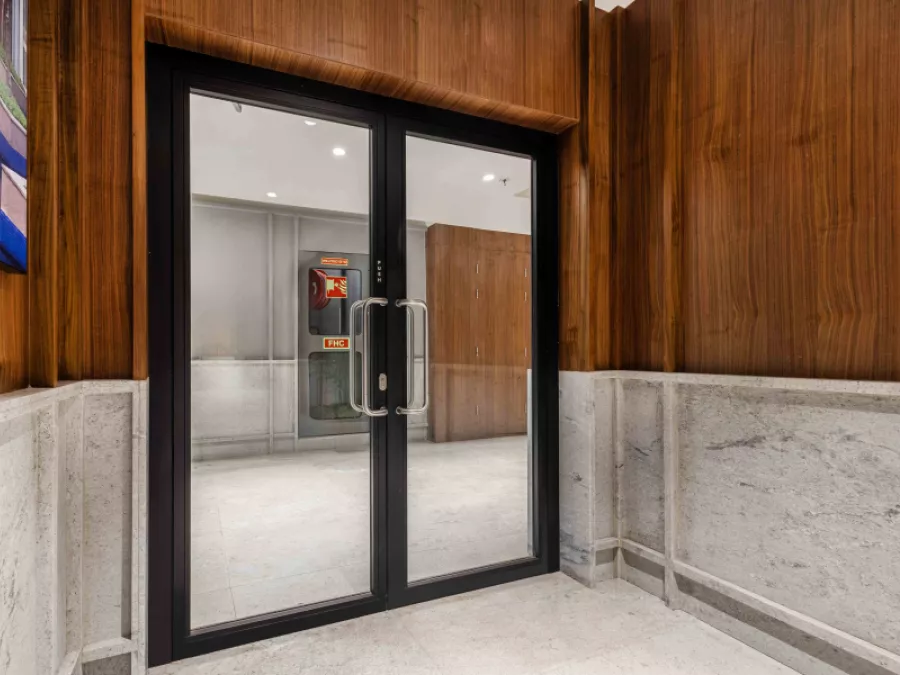Fire Doors vs Regular Doors: Why Fire Doors Are Essential for Safety

Doors are essential for access control and provide critical protection during emergencies. When it comes to fire protection, regular doors fall short, while fire doors are designed to withstand high temperatures, limit smoke spread and provide crucial time for safe evacuation.
Understanding the key differences between fire doors and regular doors highlights why fire-rated solutions are essential for ensuring safety in commercial, residential, and industrial environments.
What Are Fire Doors and Their Purpose?
Fire doors are specially engineered barriers designed to resist the spread of fire and smoke between different compartments of a building for a specific duration, typically 30, 60, 90, or 120 minutes. They are a key element of passive fire protection systems, ensuring that fire remains contained, escape routes remain protected, and structural damage is minimised.
Primary Purposes and Functions
Fire doors serve multiple critical purposes that go beyond what regular doors can offer. Their functionality ensures maximum protection during emergencies by performing the following roles:
-
Compartmentation for Fire Containment: Fire doors create fire-resistant compartments that slow the spread of flames and hot gases, giving occupants more time to evacuate safely.
-
Smoke Control: Toxic smoke is a major cause of fire-related deaths. Fire doors are equipped with intumescent seals that expand under heat, preventing smoke from spreading to escape routes.
-
Protection of Escape Routes: Fire doors installed along stairwells, corridors, and exit paths keep these routes smoke-free and passable, ensuring safe evacuation in emergencies.
-
Life-Saving Delay: By holding back fire and heat, fire doors reduce the risk of flashover (instantaneous ignition), protecting both occupants and firefighters.
-
Legal and Regulatory Compliance: Building codes (e.g., NBC, NFPA, IBC, and local fire safety laws) mandate the installation of fire doors in specific locations. Non-compliance can result in penalties and liability during emergencies.
-
Property Protection: Containing fire within a designated area limits structural damage and minimises financial losses, making fire doors essential for safeguarding valuable assets.
The Basics of Regular Doors
Regular doors are designed to provide privacy, security, and accessibility rather than fire protection. They serve as barriers between rooms, ensuring functional separation while contributing to the overall aesthetic of a space. However, when it comes to fire safety, regular doors lack the critical features required to prevent the spread of flames and smoke.
Typical Structure and Materials
Regular doors are available in a variety of materials, each offering different levels of durability and visual appeal:
-
Hollow-Core Wood: Lightweight and cost-effective, these doors are commonly used for interior applications but provide minimal resistance to fire.
-
Solid Wood: Offering greater strength and durability, solid wood doors are often used for entry points but still lack fire-resistant properties.
-
Glass Panels: Frequently included for aesthetics and natural light, glass panels in regular doors are not typically designed to withstand high temperatures.
-
Metal (Aluminium/Steel): Often used for exterior doors, metal doors provide enhanced security but do not offer adequate fire protection unless specifically treated.
-
MDF or Composite Materials: Budget-friendly and versatile, these materials are often used for interior doors but lack the structural integrity required for fire resistance.
Fire Doors vs Regular Doors: Key Differences
|
Feature |
Fire Door |
Regular Door |
|
Fire Resistance Rating |
Withstands fire for 30, 60, 90, or 120 minutes as per certified fire safety standards. |
Offers no fire resistance and burns within minutes, allowing flames to spread. |
|
Construction Materials |
Made from fire-resistant materials such as fire-rated glass, steel, gypsum, or solid timber. |
Constructed from wood, glass, or hollow-core materials with little fire resistance. |
|
Intumescent Seals & Gaskets |
Equipped with intumescent seals that expand under heat to block smoke and flames. |
No seals, allowing smoke and toxic gases to spread through gaps. |
|
Self-Closing Mechanism |
Fitted with automatic closers to ensure doors automatically shut during a fire. |
Often left open and will not close during the event of fire, allowing flames and smoke to move freely. |
|
Certification & Compliance |
Tested and certified in accordance with fire testing codes (e.g. EN 1634, IS 16947) |
No certification is required; hinges, latches, and frames are not fire-tested. |
|
Glazing (If Present) |
Fire-rated glass withstands high temperatures and maintains integrity. |
Standard glass can shatter under heat, creating additional hazards. |
Ensuring Safety Through Proper Door Selection
Fire doors play a critical role in protecting lives, property, and escape routes during emergencies. Unlike regular doors, they are engineered to resist high temperatures, prevent smoke spread, and comply with safety standards.
Whether for commercial, residential, or public spaces, investing in certified fire doors ensures long-term safety and peace of mind. Choosing the right door can mean the difference between containment and catastrophe, making fire doors an essential safeguard in any building.



